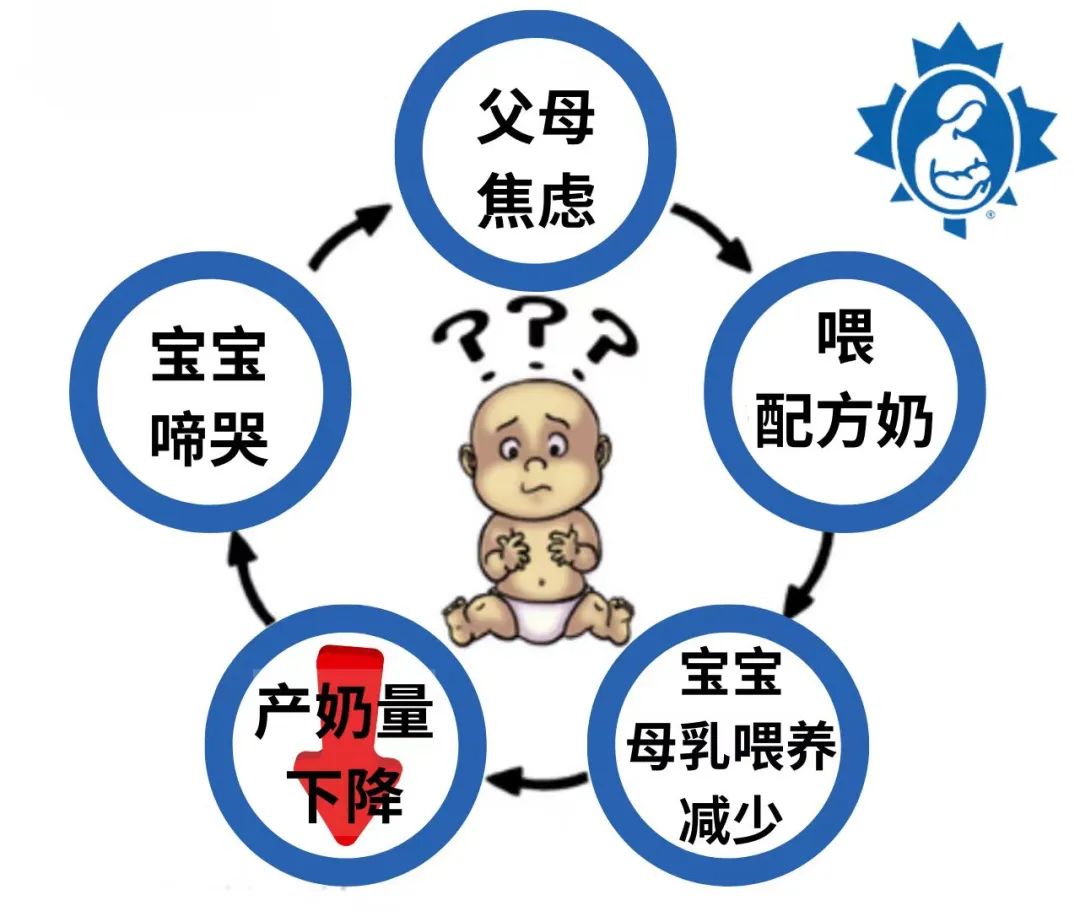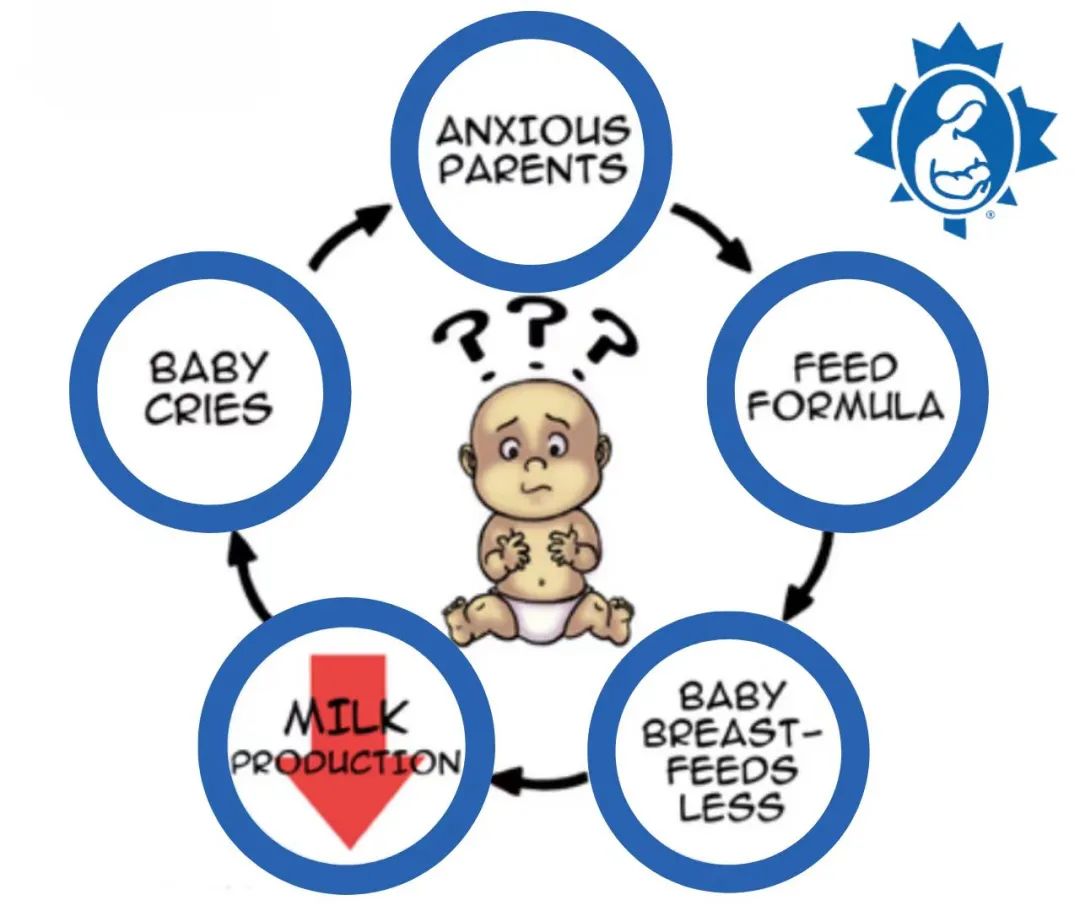点击上方国际母乳会LLL 设为星标,获取育儿知识

所有的宝宝都会哭,而有一些宝宝则经常哭。
如果是宝宝经常啼哭,妈妈会觉得沮丧又心烦。试着给宝宝拍嗝,抱着ta摇晃,但还是哭闹不已。到底是怎么了?妈妈可能担心奶量不够、喂不饱孩子,或是觉得自己的母乳质量不太好,又或是担心自己吃的东西会通过母乳让宝宝的肠胃不舒服。
你并不是唯一有这种担忧的人。
许多妈妈都担心这些。但是大多时候,宝宝的哭与妈妈乳房里的母乳的质或量都没有任何关系。
事实上,宝宝会因为很多原因而哭。哭是宝宝与你沟通的主要方式。一开始,很难弄清楚ta到底想告诉妈妈什么。宝宝可能是饿了、不开心、受伤、害怕或是孤独。
出生后的最初几天


宝宝正在适应外面的世界,宝宝经历了一些巨大的变化!出生后把宝宝放在妈妈的胸前做肌肤接触有助于宝宝适应自己的新家。当宝宝烦躁或者啼哭时,喂奶就能轻松地安抚。啼哭被认为是较晚的饥饿信号。通常宝宝会先表现出其它的饥饿迹象,比如:
吸吮手或手指
抱着时会寻找乳房
呼吸急促,躁动不安
刚开始妈妈的乳房只产生少量的初乳。早期频繁地哺乳就给了乳房信号,让它产出更多的母乳。只要在乳房上,宝宝就能通过吸吮、肌肤接触、听到熟悉的声音和心跳得到抚慰。这和吃到乳汁一样重要。
宝宝不太可能遵循一个固定的喂养模式或时间表。可能会频繁地哺乳几个小时,然后睡一个长长的觉;或者可能有一个不规律的吃奶模式。有些宝宝一天喂奶8~9次,还有些宝宝一天要喂12次以上。这些都是正常的。
啼哭和母乳喂养问题


当妈妈试着哺乳而宝宝却一直在哭时,会很让人沮丧。宝宝似乎找不到乳头或者不能正确地吸吮。这种情况下,可以抱着宝宝放在妈妈裸露的皮肤上,把ta的头放在妈妈的胸前、下巴下方,这样待几分钟直到宝宝平静下来。然后再试一次。
还可以尝试后躺式哺乳的姿势,这样宝宝就能感受到妈妈的肌肤,开始自己向乳房挪动。关于如何调整好妈妈和宝宝的身体姿势的更多资讯,可以参阅哺乳姿势和含乳姿势,这样宝宝就可以舒服地含乳了。
请记住,宝正在学着做一些全新的事情,所以可能要花很长时间才能含住乳房。对宝宝要有耐心,如果你担心,可以向他人寻求帮助(如国际母乳会的哺乳辅导、泌乳顾问、助产士或护士)。
出生三四天后


这时妈妈乳房里的奶量会明显增加。宝宝要含上充盈的乳房可能会非常费力,使ta哭闹不休。试着挤出一点儿乳汁来让乳房变得软一些,这样有助于宝宝含乳。如果不管用,就要寻求帮助了。
宝宝在出生后的头几天里体重会减轻(因为宝宝排出了黑色的胎便,而这种粪便原来在肠道里)。现在宝宝的体重开始增加了。每周增重140-250克(5-8盎司)是很典型的情况。这意味着孩子吃到了很多母乳,不用担心奶不够吃这一点了!在两次称体重的间隔期间,只要注意确保宝宝每24小时至少有6个沉沉的湿尿布和至少3个便便尿布即可。请参阅如何知道婴儿是否吃到了足够的母乳。
如果宝宝在出生后第四天还没能按预期增加体重,就要和医生或助产士谈一谈了,做一些事情来帮助宝宝在乳房上吃到更多的乳汁。
有的宝宝会在晚上哭得很厉害,许多妈妈发现宝宝在傍晚时分特别烦躁。可以的话,妈妈就在沙发上或者摇椅上休息,让宝宝随心所欲地哺乳,妈妈还会担心是某些自己正在吃喝的东西让宝宝烦躁了,其实大多数宝宝不会因为妈妈吃了或喝了什么而烦燥不安,但是有些会。如果妈妈认为这对宝宝是个问题,可以和国际母乳会的哺乳辅导或者国际认证哺乳顾问(IBCLC)聊一聊。
产后前两个月


很多宝宝伴随着成长会出现“猛长期”或“喂养频繁的日子”,这种情况发生在宝宝三周大和六周大左右。妈妈会发现以往快乐的宝宝突然开始哭得很厉害,总想要来来回回地吃奶,有时候这么吃一整天!这很正常!通常在两三天之后,宝宝就会回归以往的哺乳模式,而且看起来吃得更满足了。频繁喂养的这几天让妈妈的母乳量激增来满足宝宝的需求。
为什么不用配方奶呢?



图片文字从红箭头开始顺时针顺序:产奶量下降,宝宝啼哭,父母焦虑,喂配方奶,宝宝母乳喂养减少。
还可能是什么原因呢?


宝宝啼哭有很多原因。然而一旦他们被抱起来,就会减少哭闹。宝宝们各不相同:有些宝宝比别的宝宝更敏感、紧张。如果有狗叫,可能一个宝宝不会醒来,而另一个宝宝就会醒来大哭不止。啼哭是宝宝和妈妈交流的最大声的方式。宝宝不是想逼疯或操控妈妈,而是想让妈妈知道“有些事儿不对劲!”
有时候宝宝哭是因为想亲近妈妈、听到妈妈的声音并感受妈妈的温暖,就像ta出生前那样。假以时日,妈妈就会了解自己的宝宝,理解ta独特的哭声和信号。
可以尝试一些事情


◆主动哺乳,即使宝宝刚刚吃过。宝宝可能只是需要一点儿甜点!即使不太饿,母乳喂养也可以安抚ta。
◆紧紧抱着宝宝。可以考虑脱掉衣服,这样你们就可以肌肤接触了。这种接触往往有助于让宝宝不再啼哭。更多信息请参阅肌肤接触式育儿 。
◆带着宝宝走走。宝宝愿意四处移动,他们很喜欢成人走路的节奏。有背巾或柔软的宝宝背带的话,可以背着ta;或者直接抱着ta在厨房里忙活或在小区里溜达;妈妈也可以在摇椅上摇着ta。
◆对着宝宝说话或唱歌。宝宝在出生前就已经听了好几个月没买的声音了,很喜欢妈妈的声音。
◆一起洗个澡。如果宝宝总感到很紧张,那在温水中依偎着妈妈可能正是ta需要的放松方式。进入水中后,就可以让人帮着把宝宝放在妈妈怀里了。
◆如果这些都不管用,就试着再喂奶。宝宝可能现在准备好含上再多吃一些奶了。
伸出援助之手


有时妈妈所能为宝宝做的就是在宝宝哭的时候陪在身边。即使宝宝还在哭,妈妈的抚摸和亲近也能让宝宝安心。如果宝宝经常哭得让妈妈感到很沮丧,就请别人帮助你。或许你的伴侣、朋友或家人可以抱抱孩子,让妈妈能休息一下。请参阅伴侣和支持者如何提供帮助来获取更多想法。
这里有一个好消息:即使是经常哭的宝宝,到了两三个月大的时候也会哭得越来越少。妈妈的爱和支持将帮助宝宝认识到这个世界是一个充满关爱的地方,宝宝可以相信妈妈会一直在ta身边!
Why Do Babies Cry?

All babies cry, and some cry a lot.
When it’s your baby who is crying a lot, it can be frustrating and upsetting for you. You try burping her, rocking her – and she’s still wailing. What’s wrong? You might be worried about making enough milk to fill her up. Or think that your milk is not good enough. Or maybe you are worried that something you are eating is upsetting her tummy through your milk.
You’re not alone in these concerns. Many mothers worry about these things. But most of the time, your baby’s crying has nothing to do with the quality or amount of milk in your breasts.
The truth is that there are many reasons babies cry. Crying is the main way your baby communicates with you. At first it can be a challenge to figure out what she’s trying to tell you. Your baby may be hungry, unhappy, hurt, scared or lonely.
sucking on his hands or fingers.
searching for the breast if he’s being held.
breathing quickly and moving around restlessly.
At first, your breasts produce small amounts of colostrum. Frequent feedings in the early days signal your breasts to make more milk. When at breast, your baby is soothed by sucking, by being held skin-to-skin and by hearing your familiar voice and heartbeat. This is as important as getting your milk.
He’s not likely to follow a firm pattern or schedule for feeding. He might breastfeed very frequently for a few hours and then sleep for a longer period of time. Or he might just have an irregular pattern with his feedings. Some babies will feed 8 or 9 times a day, others will nurse more than 12 times a day. That’s all normal.
It’s frustrating when you try to breastfeed and your baby just cries. She can’t seem to find the nipple or suck properly. When this happens, cuddle your baby against your bare skin with her head on your chest, under your chin for a few minutes until she calms down. Then try again. Try a laid-back position so she can feel your skin and start to move to the breast on her own. See Positioning and Latching for more information on how to position your body and your baby so she can latch comfortably.
Remember, she’s learning to do something brand new, so it may take her more than a few minutes to latch on to the breast. Be patient with your baby, and ask for help (from a La Leche League Leader , lactation consultant, midwife or nurse) if you are worried.
At this point, the amount of milk in your breasts will increase significantly. Your baby may have trouble latching on to your fuller breasts. That might cause more crying. Try to express a little milk to make your breasts softer. This can help your baby latch on. If that doesn’t work, ask for some help.
Your baby lost weight in the first few days (as he got rid of the dark-coloured poop called meconium that was previously in his gut). Now he will start gaining. Between 140-250 grams (five and eight ounces) each week is typical. That means he is getting plenty of milk – one worry you can cross off your list! In between weight checks, just watch to be sure he has at least six heavy wet diapers and at least three poopy diapers every 24 hours. See How to Know Your Baby is Getting Enough Milk.
If your baby is not gaining weight as expected after day four, talk to your doctor or midwife. There are things you can do to help your baby get more milk at the breast.
Does your baby cry a lot in the evenings? Many mothers find their babies are extra-fussy in the evening hours. If you can, just relax on the couch or in a rocking chair and let your baby nurse as much as he wants.
Worried that something you are eating or drinking is bothering your baby? Most babies aren’t bothered by anything their mothers eat or drink, but some are. You could talk to a La Leche League Leader or an International Board Certified Lactation Consultant (IBCLC) about this if you think it is a problem for your baby.
Many babies have “growth spurts” or “frequency days” as they grow. This happens around three weeks and six weeks. You’ll notice that suddenly your usually happy baby will start to cry a lot and want to nurse much more often – sometimes all day long! This is normal. Usually, after two or three days, your baby goes back to his previous pattern of breastfeeding and seems more content. Those days of frequent feedings have boosted your milk supply to meet his needs.

What else could it be?
Babies cry for many reasons. However, when they are being held, they cry much less. Babies are all different: some are more sensitive and intense than others. One baby might not wake up if a dog barks; while another will wake up crying and keep crying. Crying is the loudest way your baby can communicate. She’s not trying to drive you crazy or manipulate you; she’s trying to let you know “something is wrong!”
How do you know what’s wrong? Sometimes your baby cries because she wants to be close to you, hear your voice, and feel your warmth, just as she did before she was born. Over time, you’ll get to know your baby and understand her unique cries and signals.
• Offer the breast, even if your baby nursed a short time ago. He may just need a little dessert! Even if he is not very hungry, breastfeeding might calm him.
• Hold him close to you. Consider undressing him so that you can be skin to skin. That contact often helps the baby stop crying. See Skin-to-Skin Care for more information.
• Take a walk with him. Babies love to move, and they love the rhythm of an adult walking. Use a wrap or soft baby carrier if you have one, or just carry him as you stroll around your kitchen or around the block. You can also rock in a rocking chair.
• Talk or sing to her. Your baby has been listening to your voice for months before she was born, and she loves the sound of it.
• Take a bath together. If your baby is feeling tense, snuggling with you in warm water might just be the relaxation she needs. A helper can place the baby in your arms once you’re in the water.
• If nothing is working, try offering the breast again. She might be ready to latch on and nurse a bit more now.
Sometimes all you can do for your baby is to be there while he cries. He will be reassured by your touch and closeness, even if he continues to cry. If your baby cries a lot, and you are getting frustrated, ask someone to help you out. Perhaps your partner or a friend or family member can hold or carry the baby while you have a break. See How Partners and Supporters Can Help for more ideas.
Here’s the good news: even babies who cry a lot tend to cry less and less as they reach two or three months of age. Your love and support will help him learn that the world is a caring place and that he can trust you to be there for him.

资料来源:https://www.lllc.ca/why-do-babies-cry


END

找到我们
微信公众号|视频号|小红书|抖音|新浪微博|今日头条|哔哩哔哩|优酷|快手
搜索关键字“国际母乳会LLL”


更多阅读资料,
欢迎大家访问“国际母乳会LLL”官网:
https://www.muruhui.org/
分享
收藏
点赞
在看

做公益也有运营成本!
你的支持和赞赏可以让更多的妈妈获益!
本篇文章来源于微信公众号: 国际母乳会LLL
